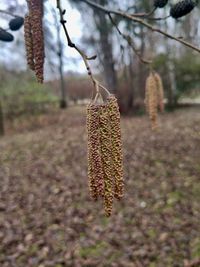Pollen information for Lower Austria from 22 December 2025
In urban areas, the first purple alders are ready to flower!
Although the weather of the last few days did not suggest it, the catkins of the purple al der have clearly developed further. In thermally favoured locations in the lowlands of Lower Austria, some of them have even reached flowering readiness.
This alder species is often planted as a park or street tree and is characterised by the fact that it starts flowering much earlier than its relatives, namely at Christmas time. The purple alder usually occurs in smaller populations than its naturally occurring relatives. As a result, the expected impact is usually limited to the immediate vicinity of the plants.
If the maximum daily temperatures rise to over 5 °C for a longer period of time in the coming days, the first, low levels of pollen count may already occur in the vicinity of purple alder. However, as the weather forecast for the Christmas holidays is predicting rather low temperatures and occasional precipitation, it is unlikely that Purple Al der will be present until the weekend.
The forecast model for the start of the alder/hazel season has also been running again for some time and is already providing initial data on the start of flowering. At the moment, this data indicates that the season will start between the end of January and the beginning of February. However, these forecasts are currently still subject to a very high degree of uncertainty. The closer we get to the actual flowering period, the more precise the calculated data will be.
Readiness to flower alder/hazel | at |
Allentsteig | 2026-02-03 |
Amstetten | 2026-01-31 |
Gumpoldskirchen | 2026-01-28 |
Gutenstein-Mariahilfberg | 2026-01-23 |
Hohe Wand/Hochkogelhaus | 2026-01-19 |
Krems | 2026-01-27 |
Lunz | 2026-02-10 |
Reichenau/Rax | 2026-01-25 |
St. Pölten | 2026-01-30 |
Tulln/Langenlebarn | 2026-01-26 |
Waidhofen/Ybbs | 2026-01-31 |
Wiener Neustadt | 2026-01-28 |
Zwerndorf-Marchegg | 2026-01-28 |
Forecast date: 2025-12-22
Note: The data shown here are model data for the expected start of flowering. For more detailed information on the expected pollen count, please refer to the text forecasts.
Responsible for the content
AZ Pollenresearch GmbH im Auftrag der Niederösterreichischen Landesregierung, Gruppe Gesundheit und Soziales, Abteilung Umwelthygiene.
Dr. rer. nat. Johannes M. Bouchal, Lukas Dirr, MSc und Mag. Sabine Kottik.
Wetterdaten und Prognosen basierend auf synoptischen Daten:
GeoSphere Austria, Bundesanstalt für Geologie, Geophysik, Klimatologie und Meteorologie (ehemals ZAMG).
zum Team


